Are you struggling to get your website noticed among millions of search results?
The problem could be that you are targeting the wrong keywords.
Keywords are the phrases and words that the audience uses for search.
Keyword research includes the three stages to get your blog on the search engine.
It includes relevancy, authority, and user signals.
Google ranks your content based on its relevance to user searches, your authority, and how your users interact with it.
Choosing the right keyword is crucial to get your content noticed.
Keyword research is a 50%of SEO.
Effective keyword research is fundamental for enhancing your online visibility, attracting the right audience, and driving traffic to your website.
Most businesses make the mistake of targeting the wrong keywords and struggle to drive traffic to their website.
Most businesses believe targeting a low search volume and having low competition keywords can help them rank their blog.
And it’s completely the wrong approach to doing keyword research.
In this “The Ultimate Guide to Do Keyword Research in 2024” I will show the steps and I will do keyword research for weight loss to explore the best techniques and tools to help you uncover high-impact keywords that resonate with your audience and align with your business goals. Ready to learn how to supercharge your SEO with smart keyword research? Let’s dive in!
What is Keyword Research?
Keyword research is a process of identifying and analyzing the words and phrases that the audience is using for search.
Those search queries help marketers, businesses, and website owners to understand what audiences are searching for and help to create relevant content that solves their audience problem and attracts more traffic to their websites.
Why Keyword Research is Important
Imagine you are creating content for your website and no one is searching for it.
Here is where most business fails to get traffic for their website.
Keyword research helps to know that there is search demand for a particular topic and audiences are searching for it.
Here are some of the reasons why Keyword research is crucial:
1. Understanding audience needs
Keyword research helps to know the terms and phrases that our audience is using for search.
This information provides clear information about what our audience is looking for, their problems, and pains, and helps to create content that meets with audience needs.
2. Improve Search Ranking
Using the right keywords in the content helps search engines to understand the what page is about.
In simple words, using the right keywords helps search engines know whether the content or page is relevant to search queries or not.
By targeting the right keywords the change of ranking the content is high and attracts more traffic for a website.
3. Competitive Advantage
Keyword research helps to know what your competitors are ranking for and which are the keywords they are using in their content their are ranking for.
By conducting thorough keyword research, you ensure that your content aligns with what your audience is looking for and enhances your overall SEO and marketing efforts.
The Ultimate Guide to Do Keyword Research in 2024
Here is an ultimate guide to doing keyword research
1. Brainstorm Seed keywords
The first and crucial step of doing keyword research is brainstorming seed keywords or broad words and phrases.
Most businesses make the mistake of searching for long-tail keywords.
The initial stage of keyword research focuses on broad keywords, which will help to expand to more relevant and long-tail keywords.
Understand your audience’s points of view and search for terms and phrases they use to search for.
For example, if you are in a weight loss niche, you’re broad keywords could be
- Weight loss diet
- Weight loss guide
- Weight loss pills
- Weight loss Juice
- Weight loss Injections
- Weight loss exercise
For this blog post here is how I find out broad keywords
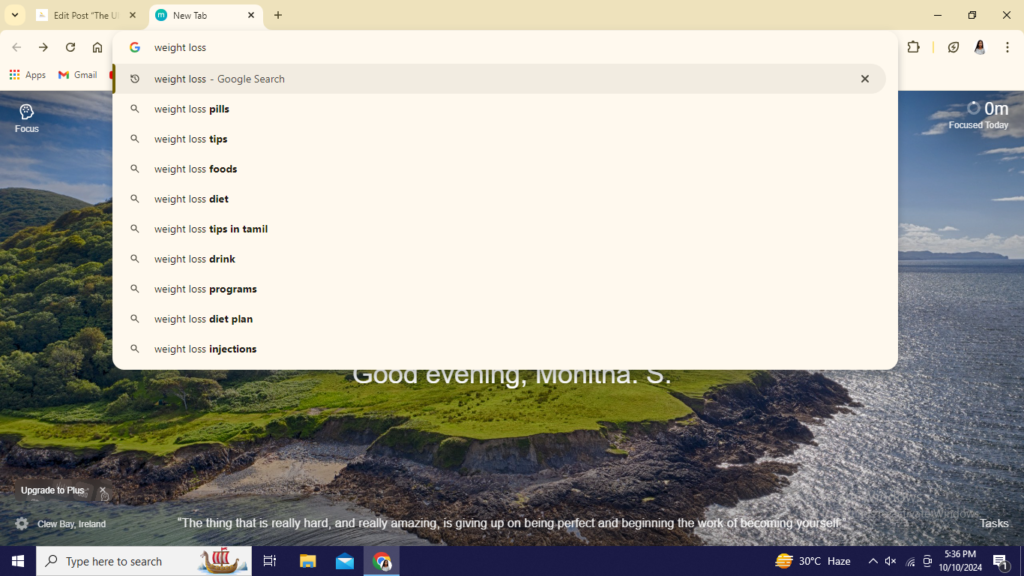
By going with the broad topic I got some broad terms that the audience is searching for.
This gives an idea of which words and phrases the audience is searching for.
2. Discover relevant keywords
Now we have discovered some seed words that our audience is searching for.
Now. the next step would be to find relevant keywords that our audience are searching.
To find those keywords you can use keyword research tools like Ahrefs, Semrush, and Google Keyword Planner and there are many other keyword research tools to figure out.
Let’s look at how you can find relevant keyword research using Google Keyword Planner.
Search Google keyword Planner and click on visit keyword planner.
Next, create a Google ads account if you don’t have an account.
If you already have a Google ads account, click on the account.
Here is What it looks like

Now click on Start with keywords enter your keywords and click on Get Results.
Now you will get a list of related keywords.
Here is my list of related keywords of “Weight loss”.
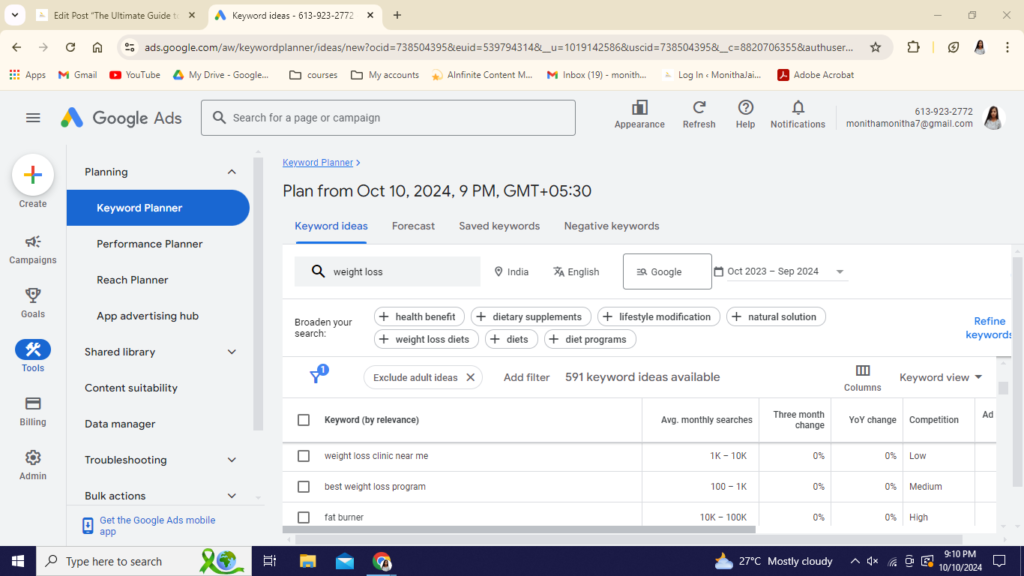
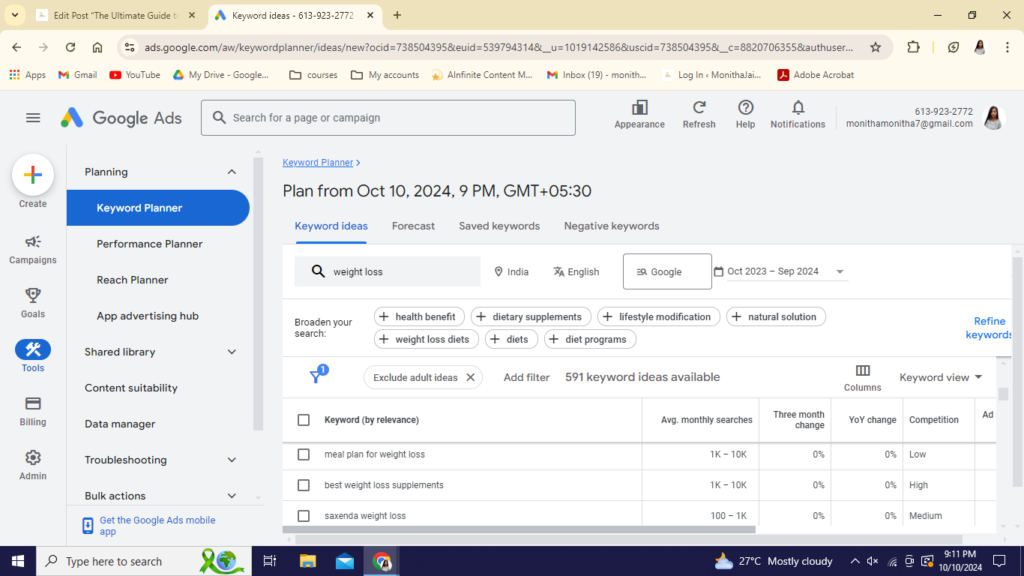
By doing this you will get an overview of several keywords and the most important topic that your audience is searching for.
3. Find Long Tail Keywords
Long-tail keywords are best to target as they provide a clear intent on what our audience is searching for.
And long-Tail Keywords have a low search volume and low competition and it helps in easy ranking.
From the seed keywords, he has discovered some short-tail keywords such as Fat burner.
This keyword Fat Burned doesn’t provide a clear intent.
Here we don’t know what the user is searching for.
Is the meaning, picture, or some exercise? The intent here is not clear here.
As we don’t know what the user is searching creating content on this keyword will be the wrong way to approach it.
Instead of going with long-tail keywords helps to know what our user is searching for.

Here we can see the intent behind the search is clear.
Weight Loss Clinic near me – In this keyword, the intent is clear. The audience is searching for a clinic for weight loss.
Best weight loss program- In this keywords. The intent is clear. The user is searching for a program for weight loss.
As the intent is clear and we get to know what our audience is looking it’s easy to provide a solution.
Let’s take another example.
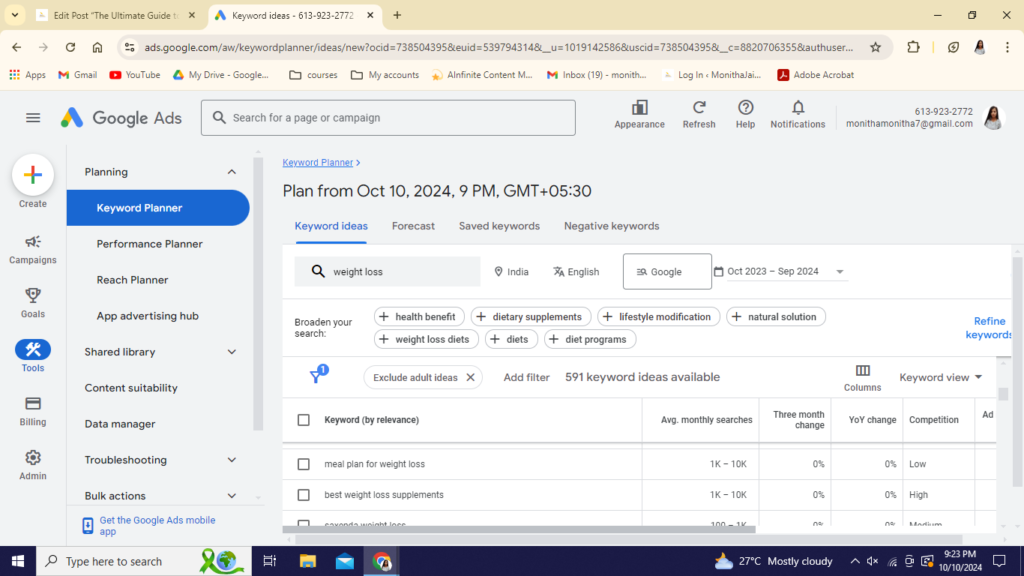
Here in these two keywords, the intent is clear.
In the 1st keyword the user is looking for a diet plan for weight and in the 2nd keyword, the user is looking for some supplements for weight loss.
Now you can see the difference between the short-tail keywords and long-tail keywords and you get the reason why I suggest you target long-tail keywords.
4. Analysis of competitor’s keywords
Now we have done some keyword research and got to know what the terms and phrases our audience is searching for.
Now that’s not enough for keyword research.
We have to know what keywords that our competitors are ranking for.
Because those keywords are not only relevant but also provide valuable information.
Here is how you can identify the keywords that your competitors are ranking for.
Click on Start with a website.
Here is what it looks like.
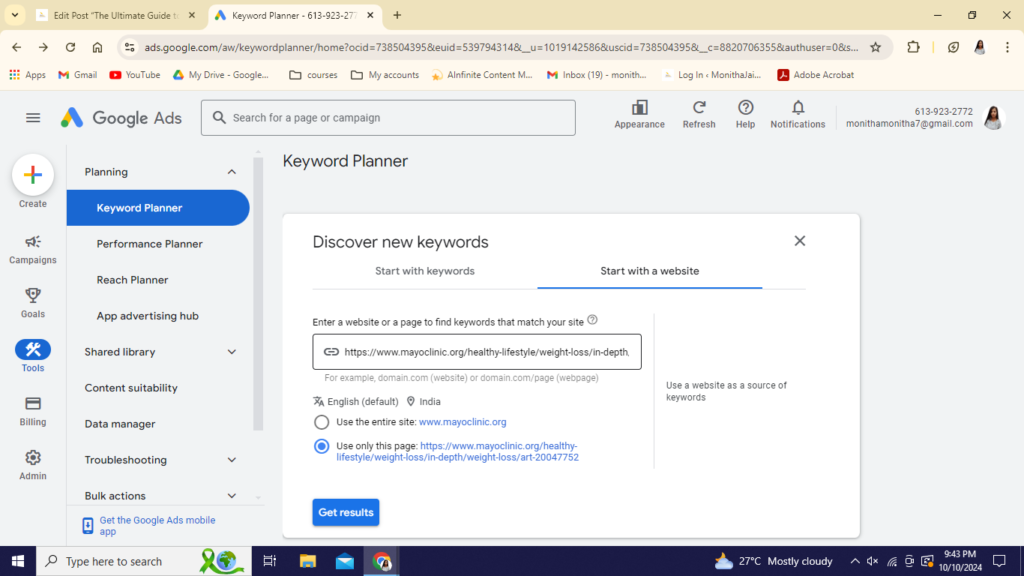
Now enter your competitor’s website.
If you want a list of keywords that your competitors used on the entire website, click on Use the entire site.
Or if you want to know about the keyword’s rank on a specific page click on Use on this page.
Click on Get Results.

Here I got 2 keywords that this page is ranking for.
Now you can customers according to the month they are ranking.
If you want to know fr keywords ranked last, last year, last 24 months, or available.
You can customize it according to your needs.
Let’s take another example.
Here I have got some keywords that are ranking.

Now I have a list of keywords that my competitors are ranking for.
This helps to know the keywords your competitors are ranking and you’re not.
It helps in identifying the gap.
5. Analysic the metrics
Now we have a list of more keywords.
Now it’s time to find the right keywords.
No, I am not saying all these keywords are wrong.
I am saying all keywords are not equal.
We need to identify the demand for a particular keyword.
Here is where search volume, keyword density, and Cost per Click (CPC) Serp features come in.
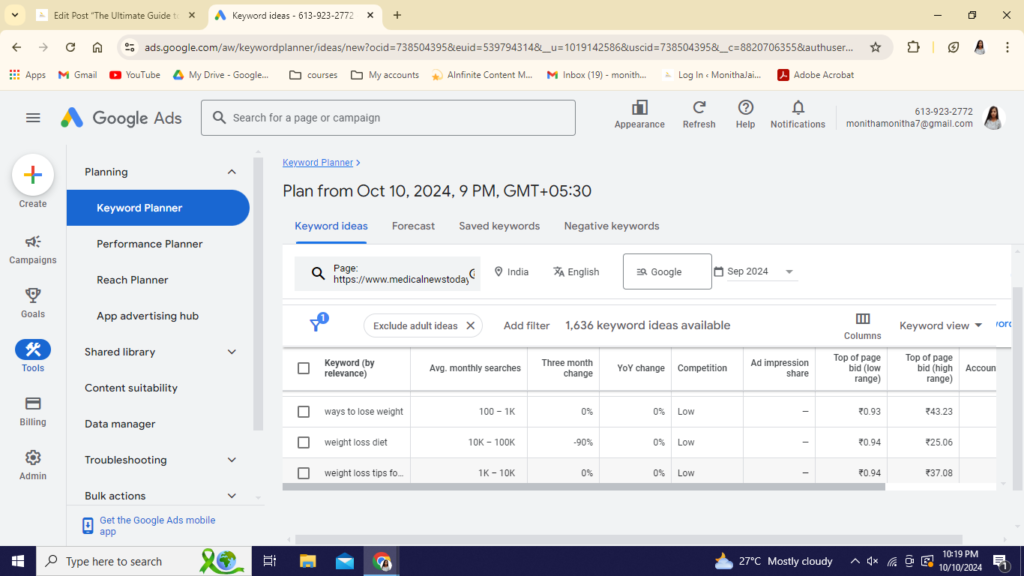
Here we can see the Average monthly searches.
That is search volume.
This search volume defines the average monthly search of a keyword.
That means how many people are searching using that particular keyword.
Now you can see for a weight loss diet the average monthly search is 10k-100k.
That means 10k-100k people are searching using that particular keyword.
And you can see the competition.
That shows the competition of a particular keyword.
Is that keyword easy to rank or not?
For the keywords weight loss diest, way to weight loss, and weight loss tips for women, when you see the competition it shows low.
On Google keyword planner the competition they show is for Google ads and mostly not related to SEO.
But you get ideas from these keywords and can use different tools such as Ahrefs, and Semrush to check out the search volumes and competitions.
That means the competition for those keywords is low and it’s easy to rank the keyword.
The next part is Ad impression share which is top of page bid (low range and high range).
That is the amount spent on a particular keyword to rank.
SERP Features These are unique listings of keywords that appear on Google’s search.
6. Determine search intend
Now it’s a bery crucial part of keyword research.
We have got a list of keywords and their search volume, competition and Cost per click.
Now it’s time to understand the intend behind the search.
Is the intent behind this keywords is awareness, discovery or transaction.
Is the user is searching for ore information or get got to know about the topic or lookig for a transaction.
Why understanding the intent behind the search is crucial?
One of the biggest misconceptions about keyword research is including more keywords in your content will result in easy ranking.
As I already mentioned it’s the biggest concept and it’s not an effective way of doing keyword research.
An effective way of doing keyword research is by understanding the intent behind the search.
The goal of keyword research is not just to get your blog rank.
But the goal is to provide a solution that your audience is looking for.
Once we understand the intent behind their search we can create content that solves their problem and give an effective solution.
By understanding the intent behind the search we can understand what’s our audience pain points, their desire, and goals.
Now, the question arises, How many times should I use keywords in my content?
And to be honest their no answer to this question.
The goal of creating content is to provide a solution.
If we focus on adding keywords we get lost in providing solutions to them.
When we focus on providing the solution, the keyword will come up naturally in our content.
Using keywords naturally in our content will be more effective.
For instance, the keyword is “Tomato Plant”
In this case, we have to neglect this keyword as it doesn’t provide a clear intent for the search.
Whether the audience is looking for the meaning of the tomato plant how to grow or where to buy it or looking for a picture of the tomato plant.
It doesn’t provide any clear intent behind the search.
Let’s take, “Why my tomato plant is turning yellow?
Here the intent behind the search is clear and we can understand what actually our audience is looking for.
Here it clearly shows the audience needs to know the reason why his tomato plant is turning yellow and he needs to solve this problem.
As the intent here is clear we can focus on creating problem-solving content.
The intent is to understand the stage of search is an awareness, discovery to purchase.
Is the audience getting awareness about the product or in the discovery stage or to purchase?
7. Organize your Keywords
Now it’s time to organize the keywords with their search volume and keyword difficulties.
Once you have a list of potential keywords, organize them into groups based on topics or themes. This will help you plan your content strategy more effectively, ensuring each piece of content targets a specific keyword group.
For example, if you have keywords related to “content marketing,” you might create sub-groups like:
- Content creation tips
- Content marketing strategies
- Content promotion techniques
This organization helps you cover topics comprehensively and prevents keyword cannibalization, where multiple pages compete for the same keyword.
8. Create a spreadsheet
Create a spreadsheet like this

This sheet helps to make a list of primary, secondary, and LSI keywords with their search volume.
This will give clarity on the search volume of the keywords and we use those keywords naturally in our content as we know what words and phrases our audience is using for the search.
9. Prioritize and plan your content
With the keywords organized, based on their relevancy, search volume, and competition, start with keywords that offer a balance of traffic and ranking potential.
Plan your content calendar that aligns with your keywords create each piece of content optimize those keywords naturally in your content and provide valuable and engaging content.
Prioritizing your keywords is essential for maximizing their impact on your business objectives. Segment your keyword list based on where they fall within the content marketing funnel:
- Top-of-the-Funnel (ToFu): High search volume keywords aimed at brand awareness (e.g., “what is SEO”).
- Middle-of-the-Funnel (MoFu): Moderate search volume keywords that indicate consideration (e.g., “best SEO tools”).
- Bottom-of-the-Funnel (BoFu): Low search volume keywords with high buyer intent (e.g., “SEO tool free trial”).
Start with BoFu keywords for immediate sales potential, then target MoFu keywords to educate prospects, and finally, include ToFu keywords to build brand awareness.
10. Monitor and Adjust
Another biggest misconception about keyword research is it is a one-time process.
Most businesses believe keyword research is a one-time process.
Keyword research is not a don’t time task.
We need to regularly monitor the performance of keywords and adapt to them.
Tools like Google Analytics and Google Search Console help to track the metrics of
- Keyword rankings
- Organic traffic
- Click-through rates (CTR)
Based on the date, we need to adjust our keyword strategy when needed and if certain keywords aren’t performing as expected sometimes, we need to consider optimizing the exciting content or keyword to target keywords.
Conclusion
Keyword research is crucial for SEO and doing it effectively is crucial for driving targeted traffic and achieving the SEO goals.
The goals of keyword research are not just to get rank but also to understand the intent behind the search to create problem-solving content.
As we have seen choosing the right keywords is crucial and it is also not a one-time process.
Keyword research needs to be monitored and adapted according to the metrics required.
Targeting the long-tail keywords or phrases shows clear intent and understanding of the type of keywords and optimizes it for your content to achieve your SEO goal.
